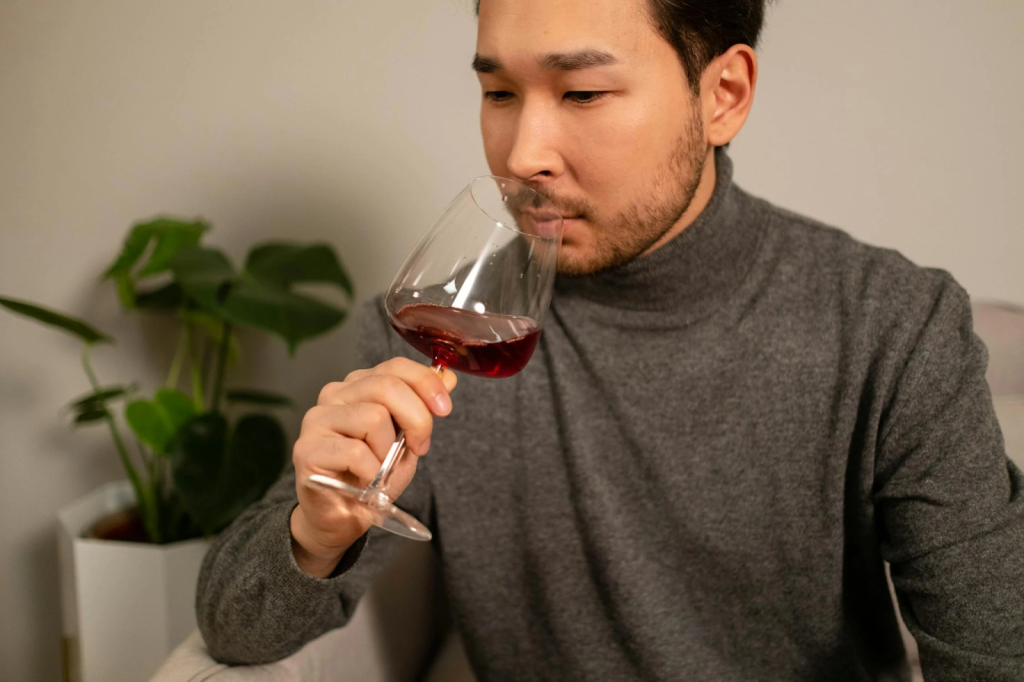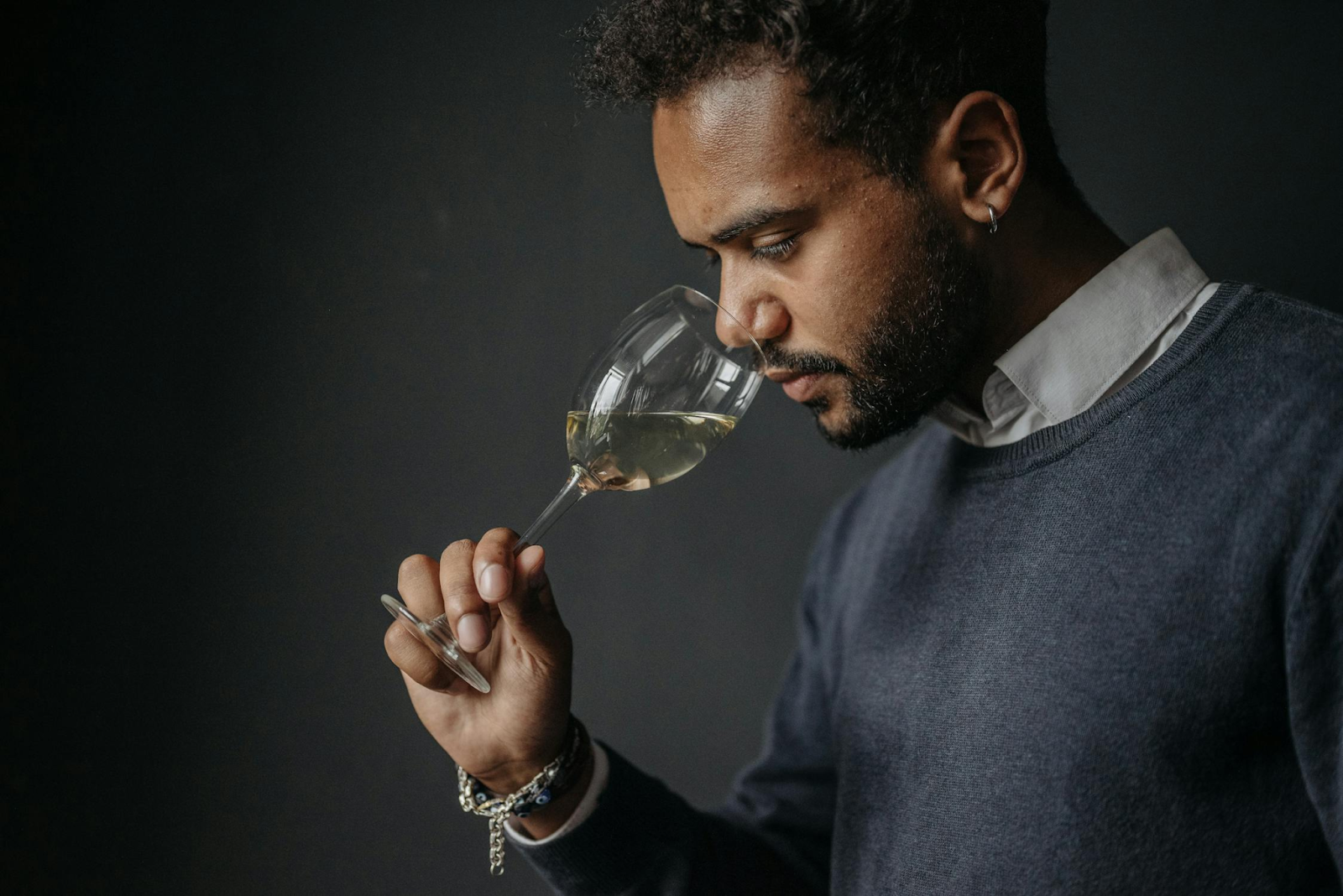Have you watched someone stick their nose to their wine glass and wondered what they are even doing? If yes, you’re not alone!
Smelling wine is art. But the good news is that it’s an easy one to learn. You can blend right into the snobbiest of wine tasting circles once you know the right method.
If your goal is not to impress but just learn how to appreciate the aromas of your bottle, even better. Keep reading to find out how to smell wine correctly.
How to Smell a Wine: A Step By Step Guide
Even if it seems like a small detail, smelling the wine correctly can really elevate your wine tasting experience. It will help you to identify the wine’s aromas, reveal a wine that has corked or has turned bad before pouring a large glass to drink. Here’s a quick guide to get started:
-
Start with the Right Temperature
Give your wine time to warm up a bit if it’s coming straight from the fridge. Cold temperatures mask aromas, so let it sit for about 10-15 minutes.
As frivolous as it sounds, this isn’t about being picky — it’s about letting your wine emit all its delicious scents. Here’s the deal:
- For Red Wines:
-
- If you’ve got it stored in a wine fridge, give it 15-20 minutes to warm up.
- Room temperature is your friend – think 62-68°F (16-20°C).
Pro Tip: Can you feel a slight chill when you touch the bottle? That’s perfect!
- For White Wines:
-
- Take the bottle out of the fridge about 10-15 minutes before you plan to drink it.
- You want it cool but not ice-cold – think 45-55°F (7-13°C).
Pro Tip: if your glass is getting foggy, your wine’s too cold.
- For Sparkling Wines:
-
- These are the divas that actually love the cold. Serve them straight from the fridge at about 38-45°F (3-7°C).
Pro Tip: Keep the bottle upright in the fridge to preserve those precious bubbles.
-
The Swirl
Hold your glass by the stem (yes, it matters!) and gently swirl the wine.
This isn’t just for show – it helps release those lovely aromas. If you’re nervous about spilling, try keeping the glass base on the table while you swirl.
Here’s a gentle reminder to avoid these common swirling mistakes:
- Swirling too hard
- Filling the glass too full
- Death-gripping the glass
- Swirling for too long
-
The First Sniff
Take a quick, light sniff without putting your nose too far into the glass. Think of it as saying “hello” to your wine.
What You Might Notice:
- Is it fruity? Spicy?
- Does it remind you of something familiar?
- Maybe you get nothing at all — that’s totally fine!
- Think of this as a movie trailer — just a quick preview of what’s to come.
-
The Deep Dive
Time to put your nose right into the glass
Take a longer, deeper sniff — don’t be shy!
Close your eyes if it helps you focus. Try taking two or three short sniffs instead of one long one.
What does it remind you of? There’s no wrong answer here.
Maybe you smell strawberries. Maybe it reminds you of your garden. Trust your nose.
Things to Remember When Smelling a Wine
While you’ve learned how to smell a wine, here are a few things you need to remember to make your experience memorable.
- Glass should be clean
Make sure your glass is spotless and free of any strong smells.
Even a hint of dish soap can mess with your wine-smelling adventure.
- Skip the Perfume
Try to avoid wearing strong perfumes or colognes when you’re planning to smell wine. They can interfere with those subtle aromas you’re trying to catch.
- Stay Fresh
Avoid coffee or strong-flavored foods right before wine tasting. Give your nose a clean slate to work with.
- Practice
Your nose gets better at identifying smells the more you practice. Keep a notebook of what you smell – it’s fun to look back on your wine journey!
Types of Aroma In Wine
If you’re a beginner who’s exploring the wine world, don’t stress about identifying every wine’s aroma right away. It takes practice to master it.
Having an understanding of the types of aroma can make the process much easier, though. Here’s what you need to know:
Primary Aromas
These are the fresh, fruity, floral, and herbal scents that come directly from the grape. Think fresh berries in red wines or citrus in whites. You might catch notes of:
- Cherries, raspberries, and plums in red wines.
- Lemons, apples, and peaches in white wines.
- Flowers, herbs, and spices in either.
Secondary Aromas
These pop up during fermentation and winemaking. They’re the bread-like, yeasty, or dairy-like smells. Look out for notes of:
- Butter (especially in Chardonnay).
- Fresh bread or pastry.
- Yogurt or cheese notes.
Tertiary Aromas
These develop as wine ages and are often called “bouquets.” They’re the complex scents that make aged wines so interesting:
- Leather and tobacco in aged reds.
- Nuts and honey in aged whites.
- Forest floor or mushrooms in aged wines, especially from grapes grown in a cooler environment.
- Vanilla and baking spices from oak aging, such as Cabernet Sauvignon.
Conclusion
Smelling wine isn’t about being fancy – it’s about enhancing your enjoyment of what’s in your glass.
Remember, everyone’s nose picks up different things, and you don’t get any “perfect” smell. The more you practice, the more confident you’ll become in identifying what you like.
So go ahead, grab a glass, and start sniffing! Your wine appreciation journey is just beginning.
A Spectacular Wine Bar Awaits You in Bali
Bali is home to some of the best local wines. And at Belle Wine Bar and Grazing Boards, we carry them and more.
Even if you’re in the nascent stages of your exploration journey, our seasoned staff will be happy to guide you through so you can enjoy the Bali wine bar experience to the fullest.
Don’t hesitate to visit or make a reservation.



